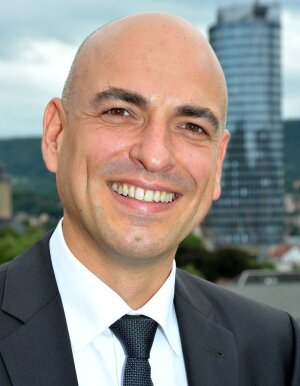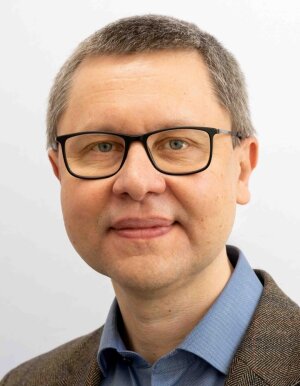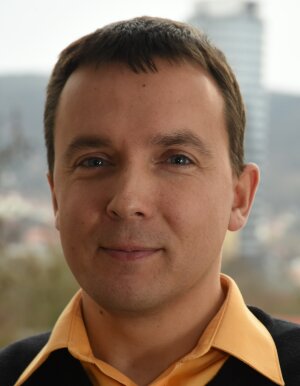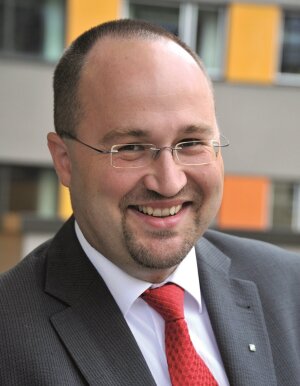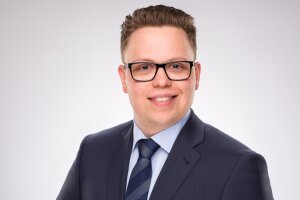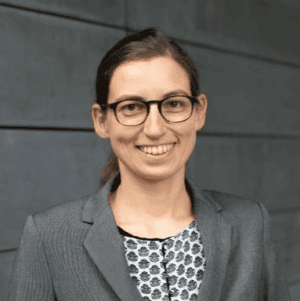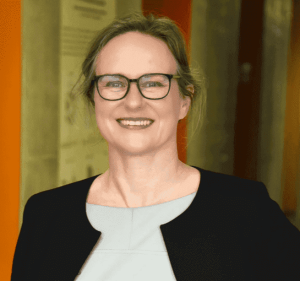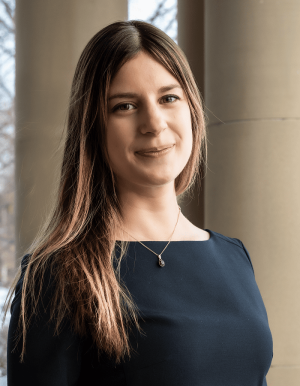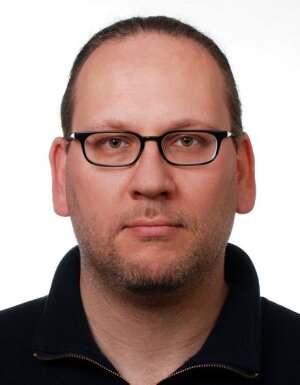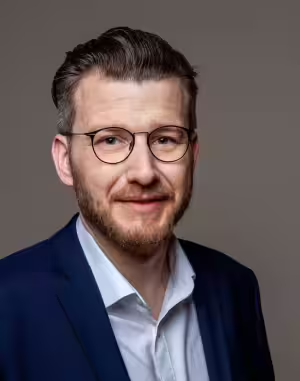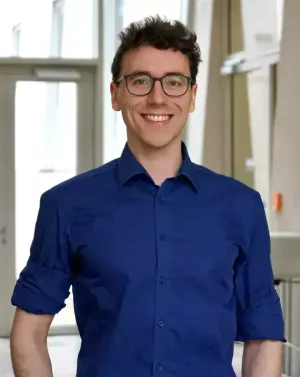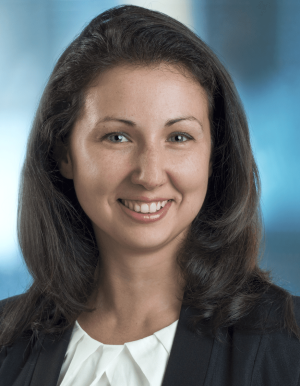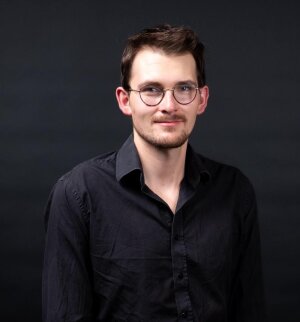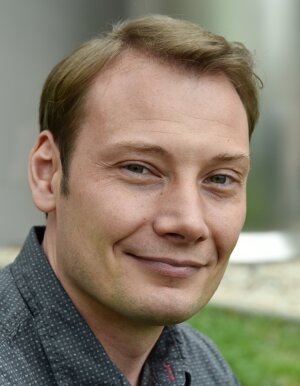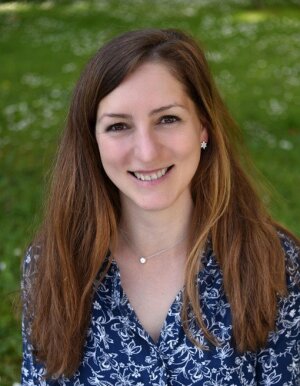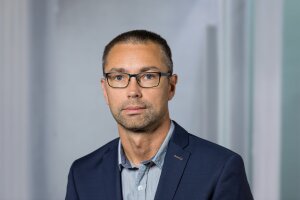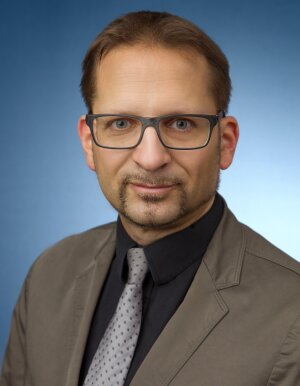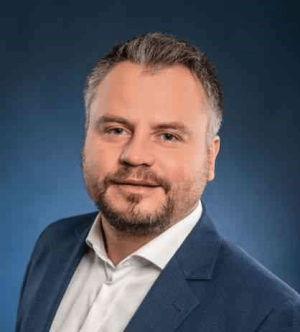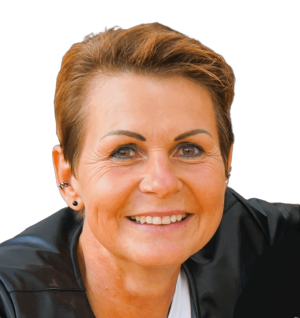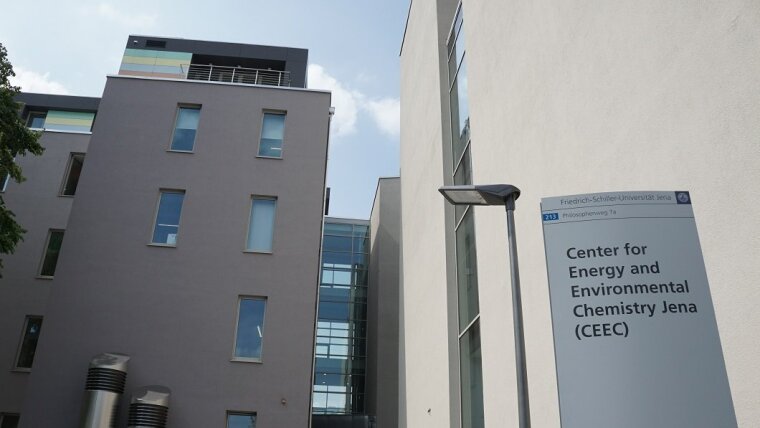
-
Prof. Dr. Ulrich S. Schubert (Vorsitzender)
Mehr erfahrenPorträt Prof. Dr. Schubert
Foto: Anne Günther (Universität Jena)Friedrich-Schiller-Universität Jena
Institut für Organische Chemie und Makromolekulare Chemie
Humboldtstr. 10
07743 Jenaulrich.schubert@uni-jena.de
Tel.: +49 3641 9-48201
Fax: +49 3641 9-48202
Forschunggebiete:- Metallo-supramolecular polymers, conjugated polymers
- Tailored functional macromolecules and nanoparticles
- Drug delivery systems & bio-compatible materials
- High-throughput experimentation, (co)polymer characterization
- Inkjet printing functional materials
- Energy creation and storage (batteries), OLED’s, sensors
- Nanolithography and nanochemistry
-
Prof. Dr. Andrea Balducci
Mehr erfahrenPorträt Prof. Dr. Andrea Balducci
Foto: Anne Günther (Universität Jena)Friedrich-Schiller-Universität Jena
Institut für Technische Chemie und Umweltchemie
Philosophenweg 7a
07743 Jenaandrea.balducci@uni-jena.de
Tel.: +49 3641 9-48464
Fax: +49 3641 9-48402Forschungsgebiete:
- Elektrochemie
- Superkondensatoren
- Lithium-Natrium-Batterien
- Ionische Flüssigkeiten
Ausgewählte Publikationen:- F. Béguin, V. Presser, A. Balducci, E. Frackowiak
"Carbons and Electrolytes for Advanced Supercapacitors"
Advanced Materials, 2014, 26, 2219-2251.
DOI: 10.1002/adma.201304137Externer Link - C. Schütter, T. Husch, M. Korth, A. Balducci
"Toward New Solvents for EDLCs: From Computational Screening to Electrochemical Validation"
Journal of Physical Chemistry Part C 2015, 119, 13413-13424.
DOI: 10.1021/acs.jpcc.5b02113Externer Link - S. Menne, J. Pires, M. Anouti, A. Balducci
"Protic ionic liquids as electrolytes for lithium-ion batteries"
Electrochemistry Communications 2013, 31, 39-41.
DOI: 10.1016/j.elecom.2013.02.026Externer Link - A. Krause, A. Balducci
"High voltage electrochemical double layer capacitor containing mixtures of ionic liquids and organic carbonate as electrolyte"
Electrochemistry Communications 2011, 13, 814-817.
DOI: 10.1016/j.elecom.2011.05.010Externer Link - X. Zhang, R.-S Kühnel, H. Hu, D. Eder, A. Balducci
"Going nano with protic ionic liquids - the synthesis of carbon coated Li3V2(PO4)3 nanoparticles encapsulated in a carbon matrix for high power lithium-ion batteries"
Nano Energy 2015, 12, 207-214.
DOI: 10.1016/j.nanoen.2014.12.008Externer Link
-
Prof. Dr. Andrey Turchanin
Mehr erfahren enProf. Dr. Andrey Turchanin
Foto: Jens Meyer (Universität Jena)Friedrich-Schiller-Universität Jena
Institut für Physikalische Chemie
Lessingstraße 10
07743 Jenaandrey.turchanin@uni-jena.de
Tel.: +49 3641 9-48370
Fax: +49 3641 9-48302Forschungsgebiete:
- Maßgeschneiderte Synthese von neuartigen zwei-dimensionalen (2D) Materialien: organische Monolagen und Dünnfilme, Graphen, Kohlenstoff-Nanomembranen, laterale freitragende Heterostrukturen, van der Waals Heterostrukturen, biofunktionale Oberfläche und Grenzflächen
- Materialwissenschaftliche spektroskopische und mikroskopische Charakterisierung von organischen und anorganischen Nanomaterialien auf der Nanometerskala, Untersuchung von Wachstumsmechanismen, elektronischen und optischen Eigenschaften und Bio-Kompatibilität
- Verwendung von 2D-Funktionsmaterialien in neuartigen Bauteilen: Elektrochemische Sensoren für hochspezifische und hochsensitive Detektion von Biomarkern, Feldeffekt-Transistoren auf Kohlenstoffbasis u.a. für flexible Elektronik, biofunktionale Nanomembranen für hochauflösende Transmissions-Elektronenmikroskopie von Proteinen, photoaktive Nanomembranen für künstliche Photosynthese, nanophotonische Strukturen
Ausgewählte aktuelle Publikationen:
- Babu, C. Neumann, M. Enke, A. Lex-Balducci, A. Turchanin, U. S. Schubert, A. Balducci,
Aging processes in high voltage lithium-ion capacitors containing liquid and gel-polymer electrolytes.
J. Power Sources 496 ,2021, 229797.
DOI: 10.1016/j.jpowsour.2021.229797Externer Link - Griffin, L. Mogg, G. P. Hao, K. Gopinadhan, C. Bacaksiz, G. Lopez-Polin, T. Y. Zhou, V. Guarochico, J. Cai, C. Neumann, A. Winter, M. Mohn, J. H. Lee, J. Lin, U. Kaiser, I.V. Grigorieva, K. Suenaga, B. Ӧzyilmaz, H. M. Cheng, W. C. Ren, A. Turchanin, F. M. Peeters, A.K. Geim, M. Lozada-Hidalgo,
Enhanced proton and Li-ion permeation through graphene with eight-atom-ring defects.
ACS Nano 14 ,2020, 7280–7286.
DOI: 10.1021/acsnano.0c02496Externer Link - Brehm, A. L. Santhosha, Z. Zhang, C. Neumann, A. Turchanin, A. Martin, N. Pinna, M. Seyring, M. Rettenmayr, J. R. Buchheim, P. Adelhelm,
Copper thiophosphate (Cu3PS4) as electrode for sodium-ion batteries with ether electrolyte.
Adv. Func. Mater. 30 ,2020, 1910583.
DOI: 10.1002/adfm.201910583Externer Link - Wang, Y. Fu, F. Wang, Z. Liao, C. Neumann, A. Turchanin, G. Nam, E. Zschech, J. Cho, J. Zhang, X. Feng,
Confined growth of porous nitrogen-doped cobalt oxide nanoarrays as bifunctional oxygen electrocatalysts for rechargeable zinc–air batteries.
Energy Stor. Mater. 26, 2020, 157-164.
DOI: 10.1016/j.ensm.2019.12.043Externer Link - Neumann, D. Kaiser, M. J. Mohn, M. Füser, N.-E. Weber, O. Reimer, A. Gölzhäuser, T. Weimann, A. Terfort, U. Kaiser, A. Turchanin,
Bottom-up synthesis of graphene monolayers with tunable crystallinity and porosity.
ACS Nano 13, 2019, 7310-7322.
DOI: 10.1021/acsnano.9b03475Externer Link
-
Prof. Dr. Lothar Wondraczek
Mehr erfahrenExterner LinkPorträt von Prof. Dr. Lothar Wondraczek
Friedrich-Schiller-Universität Jena
Otto-Schott-Institut für Materialforschung
Fraunhoferstraße 6
07743 Jenalothar.wondraczek@uni-jena.de
Tel.: +49 3641 9-48504
Fax: +49 3641 9-48502 -
Prof. Dr. Michael Stelter
Mehr erfahrenPorträt Prof. Dr. Michael Stelter
Foto: Anne Günther (Universität Jena)Friedrich-Schiller-Universität Jena
Institut für Technische Chemie und Umweltchemie
Philosophenweg 7a
07743 JenaMichael.Stelter@uni-jena.de
Tel.: +49 3641 9-48430
Fax: +49 3641 9-48402Fraunhofer-Institut für Keramische Technologien und Systeme IKTS
Michael-Faraday-Str. 1
07629 HermsdorfE-MailExterner Link
Tel.: +49 36601 93010-3031
Fax: +49 351 255-4208Forschungsgebiete:
- Wassertechnologie (Advanced Oxidation Processes, Membranverfahren, anthropogene Mikroschadstoffe, Mikroplastik, Wertstoffrückgewinnung aus Abwasser, Sensorik)
- Kavitation (Generierungsverfahren, Kavitationsfeldanalyse, Reaktorentwicklung, Sonochemie, Prozessintensivierung, Kombinationsverfahren)
- Nachwachsende Rohstoffe (stoffliche und/oder energetische Verwertungsoptionen, Prozessintensivierung, Biokraftstoffe, Bioenergie)
-
Dr. Alexander Knebel
Dr. Alexander Knebel
Foto: Dr. Alexander KnebelFriedrich-Schiller-Universität Jena
Philosophenweg 7a
07743 Jenaalexander.knebel@uni-jena.de
Tel.: +49 3641 9-48505
Homepage: www.knebelgroup.uni-jena.deExterner Link
Forschungsgebiete:Gastransporteigenschaften in porösen Metall-Organischen Netzwerken (MOF) und Kovalent Organischen Netzwerken (COF) und daraus weiterentwickelten Materialien (poröse Flüssigkeiten und Gläser). Die Materialien werden als Membranen für die energieeffiziente Gastrennung verwendet. Darunter wären Anwendungsfelder wie Wasserstoffreinigung, Carbon Capture und Erdgasaufwertung, sowie Darstellung hochreiner Grundchemikalien für die chemische Produktion zu nennen. Ein Seitenarm meiner Membranforschung befasst sich ebenso der Aufreinigung von chemisch verseuchten Abwässern. Ebenso beschäftige ich mich mit kapazitiven und optischen Sensoren (hauptsächlich Gas Sensorik) mit MOF Dünnschichten.
Ausgewählte Publikationen:
- A. Knebel, A. Bavykina, S.J. Datta,[…] M. Eddaoudi, J. Caro, J. Gascon,
Solution processable metal–organic frameworks for mixed matrix membranes using porous liquids.
Nature Materials 2020 19, 1346–1353.
DOI: 10.1038/s41563-020-0764-yExterner Link - A. Knebel, J. Caro,
Metal–organic frameworks and covalent organic frameworks as disruptive membrane materials for energy-efficient gas separation.
Nature Nanotechnology, 2022,17, 911–923.
DOI: 10.1038/s41565-022-01168-3Externer Link - H. Fan, J. Gu, H. Meng, A. Knebel, J. Caro,
High-Flux Membranes Based on the Covalent Organic Framework COF-LZU1 for Selective Dye Separation by Nanofiltration.
Angewandte Chemie International Edition 2018 57, 15, 4083-4087.
DOI: 10.1002/anie.201712816Externer Link - B. Hosseini Monjezi, B. Sapotta, S. Moulai, […] A. Knebel,
Metal-Organic Framework MIL-68(In)-NH2 on the Membrane Test Bench for Dye Removal and Carbon Capture,
Chemie Ingenieur Technik 2022 94, 1-2, 135-144.
DOI: 10.1002/cite.202100117Externer Link - B. Hosseini Monjezi, K. Kutonova, M. Tsotsalas, S. Henke, A. Knebel,
Current Trends in Metal–Organic and Covalent Organic Framework Membrane Materials,
Angewandte Chemie International Edition 2021 60, 28, 15153-15164 (2021).
DOI: 10.1002/anie.202015790Externer Link
Gemeinsame Publikationen mit Mitgliedern des CEEC Jena:
- B. Hosseini Monjezi, S. Okur, R. Limbach, A. Chandresh, K. Sen, T. Hashem, M. Schwotzer, L. Wondraczek, C. Wöll, A. Knebel,
Fast Dynamic Synthesis of MIL-68 (In) Thin Films in High Optical Quality for Optical Cavity Sensing, Preprint,
ChemRxiv 2022.
DOI: 10.26434/chemrxiv-2022-7kxlhExterner Link - V. Nozari, O. Smirnova, J.M. Tuffnell, A. Knebel, T.D. Bennett, L. Wondraczek,
Low-Temperature Melting and Glass Formation of the Zeolitic Imidazolate Frameworks ZIF-62 and ZIF-76 through Ionic Liquid Incorporation,
Advanced Materials Technologies, 2022, 7, 11, 2200343 (2022).
DOI: 10.1002/admt.202200343Externer Link
- A. Knebel, A. Bavykina, S.J. Datta,[…] M. Eddaoudi, J. Caro, J. Gascon,
-
Jun.-Prof. Dr. Andrea Pannwitz
Juniorprofessur Dr. Andrea Pannwitz
Foto: E. EberhardtFriedrich-Schiller-Universität Jena
Institut für Anorganische und Analytische Chemie (IAAC)
Humboldtstr. 8
07743 JenaTel.: +49 3641948113
E-mail: andrea.pannwitz@uni-jena.de
Homepage: https://pannwitzgroup.comExterner LinkForschungsgebiete:
- Molekulare Katalyse
- Licht-getriebene Prozesse
- Kompartimentierung
Ausgewählte Publikationen:
- A. Abbas, E. Oswald, J. Romer, A. Lenzer, M. Heiland, C. Streb, C. Kranz, A. Pannwitz,
Initial quenching efficiency determines light-driven H2 evolution of [Mo3S13]2- in lipid bilayers,
Chemistry - A Euopean Journal, 2023, e202302284.
DOI: 10.1002/chem.202302284Externer Link - B. Bagemihl, A. Pannwitz, S. Rau,
Gatekeeping Effect of Ancillary Ligand on Electron Transfer in Click Chemistry Linked Tris-Heteroleptic Ruthenium(II) Donor-Photosensitizer-Acceptor Triads.
Solar RRL, 2023, 7, 2201135.
DOI: 10.1002/solr.202201135Externer Link - N. Sinambela, R. Jacobi, D. Hernández-Castillo, E. Hofmeister, N. Hagmeyer, B. Dietzek, L. González, A. Pannwitz
Alignment and Photooxidation Dynamics of a Perylene Diimide Chromophore in Lipid Bilayers.
Molecular Systems Design & Engineering, 2023.
DOI: 10.1039/D2ME00243DExterner Link - A. Pannwitz, D. M. Klein, S. Rodríguez-Jiménez, C. Casadevall, H. Song, E. Reisner, L. Hammarström, S. Bonnet, Roadmap towards Solar Fuel Synthesis at the Water Interface of Liposome Membranes.
Chemical Society Reviews, 2021, 50, 4833-4855.
DOI: 10.1039/D0CS00737DExterner Link - H. Song, A. Amati, A. Pannwitz, S. Bonnet, L. Hammarström,
Mechanistic Insights into the Charge Transfer Dynamics of Photocatalytic Water Oxidation at the Lipid Bilayer−Water Interface.
Journal of the American Chemical Society, 2022, 144, 19353–19364.
DOI: 10.1021/jacs.2c06842Externer Link
-
Prof. Dr. Benjamin Dietzek-Ivanšić
Mehr erfahrenExterner LinkFriedrich-Schiller-Universität Jena
Institut für Physikalische Chemie
Helmholtzweg 4
07743 Jenabenjamin.dietzek@uni-jena.de
Tel.: +49 3641 9-48360
Fax: +49 3641 9-48302 -
Prof. Dr. Birgit Weber
Prof. Dr. Birgit Weber
Foto: Prof. Dr. Birgit WeberInstitut für Anorganische und Analytische Chemie,
Humboldtstr. 8, (Raum 1.28)
07743 JenaTel.: +49 3641 9-48150
E-Mail: birgit.weber@uni-jena.de
Homepage: https://www.chemgeo.uni-jena.de/10736/arbeitsgruppe-prof-dr-birgit-weberForschungsgebiete:
- Schaltbare 3d-Metallkomplexe für smarte Materialien, z.B. in Batterien
- Lumineszierende 3d-Metallkomplexe und deren Anwendung (Sensoren, Photokatalyse)
- Synthese und Charakterisierung von Nanopartikeln und Kompositmaterialien von Komplexen, und von Komplexen auf Oberflächen
- Charakterisierung magnetischer Eigenschaften von Komplexen (Festkörper, Lösung, Kompositmaterial) und von (strukturierten) Festkörpern (SQUID-Messungen, NMR-Spektroskopie an paramagnetischen Systemen, Mößbauer-Spektroskopie)
Ausgewählte Publikationen:
- H. Kurz; K. Schötz; I. Papadopoulos; F. W. Heinemann; H. Maid; D. M. Guldi; A. Köhler; G. Hörner; B. A Weber,
Fluorescence-Detected Coordination-Induced Spin State Switch.
J. Am. Chem. Soc., 2021, 143, 3466-3480,
DOI: 10.1021/jacs.0c12568Externer Link - C. Göbel; C. Hils; M. Drechsler; D. Baabe; A. Greiner; H. Schmalz; B. Weber
Confined Crystallization of Spin-Crossover Nanoparticles in Block-Copolymer Micelles.
Angew. Chem. Int. Ed., 2020, 59, 5765-5770,
DOI: 10.1002/anie.201914343Externer Link - Kurz, H.; Hils, C.; Timm, J.; Hörner, G.; Greiner, A.; Marschall, R.; Schmalz, H.; B. Weber
Self-Assembled Fluorescent Block Copolymer Micelles with Responsive Emission.
Angew. Chem. Int. Ed., 2022,
DOI: 10.1002/anie.202117570Externer Link - C. Göbel; K. Marquardt; D.Baabe; M. Drechsler; P. Loch; J. Breu; A. Greiner; H. Schmalz; B. Weber
Realizing Shape and Size Control for the Synthesis of Coordination Polymer Nanoparticles templated by diblock copolymer micelles.
Nanoscale, 2022, 14, 3131-3147,
DOI: 10.1039/D1NR07743KExterner Link - L. Zappe; S. Schönfeld; G. Hörner; K. A. Zenere; C. F. Leong; C. J Kepert; D. M. D`Alessandro; B. Weber; S. M.Neville
Spin crossover modulation in a coordination polymer with the redox-active bis-pyridyl tetrathiafulvalene (py2TTF) ligand.
Chem. Commun., 2020, 56, 10469–10472,
DOI:10.1039/d0cc03788eExterner Link
-
Dr. Desirée Leistenschneider
Desirée Leistenschneider
Foto: Desirée LeistenschneiderFriedrich-Schiller-Universität Jena
Institut für Technische Chemie und Umweltchemie
Philosophenweg 7a
07743 Jenadesiree.leistenschneider@uni-jena.de
Tel.: +49 3641 9-48438
Fax: +49 3641 9-48202Forschungsgebiete:
- Al-N2-Batterien
- Kohlenstoffbasierte Materialien für Energiespeicheranwendungen
Ausgewählte Publikationen:
- M. Dvoyashkin, D. Leistenschneider, J.D. Evans, M. Sander, L. Borchardt ,Revealing the impact of hierarchical pore organization in supercapacitor electrodes by coupling ionic dynamics at micro‐and macroscales,
Advanced Energy Mat., 2021, 11 (24), 2100700.
DOI: 10.1002/aenm.202100700Externer Link - E. Troschke, D. Leistenschneider, T. Rensch, S. Grätz, J. Maschita, S. Ehrling, B. Klemmed, B. V. Lotsch, A. Eychmüller, L. Borchardt, S. Kaskel, In Situ Generation of Electrolyte inside Pyridine‐Based Covalent Triazine Frameworks for Direct Supercapacitor Integration,
ChemSusChem, 2020, 13, 3192.
DOI: 10.1002/cssc.202000518Externer Link - D. Leistenschneider, P. Zuo, Y. Kim, Z. Abedi, D. G. Ivey, A. de Klerk, X. Zhang, W. Chen,
A mechanism study of acid-assisted oxidative stabilization of asphaltene-derived carbon fibers,
Carbon Trends, 2021, 5, 100090.
DOI: 10.1016/j.cartre.2021.100090Externer Link - D. Leistenschneider, Z. Abedi, D.G. Ivey, Coating of low-cost asphaltenes-derived carbon fibers with V2O5 for supercapacitor application, Energy Fuels, 2022, 36, 6, 3328–3338.
DOI: 10.1021/acs.energyfuels.2c00066Externer Link - Z. Abedi, D. Leistenschneider, W. Chen, D.G. Ivey, Spinel Type Mn-Co Oxide Coated Carbon Fibers as Efficient Bifunctional Electrocatalysts for Zinc-Air Batteries,
Batteries Supercaps, 2022, 5, 2, e202100339.
DOI: 10.1002/batt.202100339Externer Link
-
Prof. Dr. Falko Langenhorst
Mehr erfahrenExterner LinkFriedrich-Schiller-Universität Jena
Institut für Geowissenschaften
Burgweg 11
07749 Jenafalko.langenhorst@uni-jena.de
Tel.: +49 3641 9-48731
Fax: +49 3641 9-48702 -
Prof. Dr. Felix Helmut Schacher
Mehr erfahren enPorträt Prof. Dr. Felix H. Schacher
Foto: Prof. Dr. Felix H. SchacherFriedrich-Schiller-Universität Jena
Institut für Organische Chemie und Makromolekulare Chemie
Jena Center of Soft Matter
Lessingstr. 8
07743 Jenafelix.schacher@uni-jena.de
Tel.: +49 3641 9-48250
Fax: +49 3641 9-48252Forschungsgebiete:
- Polymersynthese (kontrollierte/lebende Methoden)
- Blockcopolymere
- Selbstassemblierung
- nanostrukturierte und/oder hierarchisch strukturierte Materialien
- responsive Membranen
- Hybridpartikel
Ausgewählte Publikationen:
- T. Press, A. Ramoji, A. C. Rinkenauer, M. vd Lühe, J. Hoff, M. Butans, C. Rössel, C. Pietsch, U. Neugebauer, F. H. Schacher, M. Bauer,
Cargo-Carrier Interactions Significantly Contribute to Micellar Conformation and Biodistribution,
NPG Asia Materials, 2017, 9, e444.
DOI: 10.1038/am.2017.161Externer Link - Wendler, K. R. A. Schneider, B. Dietzek, F. H. Schacher, "Light-Responsive Terpolymers Based on Polymerizable Photoacids", Polym. Chem., 2017, 8, 2959-2971.
DOI: 10.1039/C7PY00571GExterner Link - Rudolph, M. v. d. Lühe, M. Hartlieb, S. Norsic, U. S. Schubert, C. Boisson, F. D'Agosto, F. H. Schacher,
Towards anisotropic hybrid materials: Directional crystallization of amphiphilic polyoxazoline-based triblock terpolymers,
ACS Nano, 2015, 9, 10085-10098.
DOI: 10.1021/acsnano.5b03660Externer Link - Hörenz, T. Rudolph, M. J. Barthel, U. Günther, F. H. Schacher,
Amphiphilic polyether-based block copolymers as crosslinkable ligands for Au nanoparticles,
Polym. Chem., 2015, 6, 5633-5642.
DOI: 10.1039/C4PY01434KExterner Link - C. Rinkenauer, A. Schallon, U. Günther, M. Wagner, E. Betthausen, U. S. Schubert, F. H. Schacher,
A paradigm change: Efficient transfection of human leukemia cells by stimuli-responsive multicompartment micelles,
ACS Nano, 2013, 7, 9621-9631.
DOI: 10.1021/nn402072dExterner Link
Alle PublikationenExterner Link
Das Thüringer Ministerium für Wirtschaft, Wissenschaft und Digitale Gesellschaft
Ziel im vorliegenden Projekt ist die Entwicklung neuartiger Membranen durch Kombination von Polymermembranen und nanoporösen anorganischen Adsorbenzien in sogenannten Mixed-Matrix-Membranen oder Kompositmembranen. Als Adsorbenzien sollen Zeolithpulver und Metal Organic Frameworks (MOFs) verwendet werden. Im Rahmen der Forschungsgruppe werden Grundlagenuntersuchungen zu den Adsorbenzien (MOF, Zeolithe), ihrer Modifizierung zur optimalen Einbettung in die Polymere, zur Polymer- und Membransynthese, zur Untersuchung der Transport- und Trenneigenschaften und zur Modellierung des Stofftransportes durch-geführt. Zielstellung sind Membranen für Paraffin/Olefin-Trennung und Aliphaten/Aromaten-Trennung. Beide Trennungen zählen zu den energieintensivsten thermischen Trennungen in der Chemie. Darüber hinaus werden die Membranen bezüglich ihrer Wasserstoff- und Kohlendioxid-Trenneigenschaften sowie hinsichtlich des Einsatzes für Stofftrennungen über die Pervaporation untersucht
-
Prof. Dr. Frank A. Müller
Mehr erfahrenExterner LinkFriedrich-Schiller-Universität Jena
Otto-Schott-Institut für Materialforschung
Löbdergraben 32
07743 Jenafrank.mueller@uni-jena.de
Tel.: +49 3641 9-47750
Fax: +49 3641 9-47702Forschungsgebiete:
- Bioinspirierte Materialien (Biomineralisation, biomimetische Oberflächen, Strukturhybride) und Lasermaterialbearbeitung (Nanopartikelsynthese; Oberflächenmodifizierung; additive Herstellverfahren; Beschichtungen) für Anwendungen in den Bereichen Biomaterialien, Energie- und Umwelttechnik.
Ausgewählte Publikationen:
- A. Tesch, C Wenisch, K.H. Herrmann, J.R. Reichenbach, P. Warncke, D. Fischer, F.A. Müller
Luminomagnetic Eu3+- and Dy3+-doped hydroxyapatite for multimodal imaging
Mater. Sci. Eng., 2017, C 81, 422-431.
DOI: 10.1016/j.msec.2017.08.032Externer Link - S. Engel, D. Smykalla, B. Ploss, .S Gräf, F.A. Müller
Effect of (Cd:Zn)S particle concentration and photoexcitation on the electrical and ferroelectric properties of (Cd:Zn)S/P(VDF-TrFE) composite films
Polymers, 2017, 9, 650. - F.A. Müller, C. Kunz, S. Gräf
Bio-inspired functional surfaces based on laser-induced periodic surface structures
Materials, 2016, 9, 476.
DOI: 10.3390/polym9120650Externer Link - J.F. Bartolome, A. Smirnov, H.D. Kurland, J. Grabow, F.A. Müller
New ZrO2-Al2O3nanocomposite fabricated from hybrid nanoparticles prepared by CO2 laser co-vaporization
Sci. Rep., 2016, 6, 20589.
DOI: 10.1038/srep20589Externer Link - C. Stolze, T. Janoschka, S. Flauder, F.A. Müller, M. Hager, U.S. Schubert,
Investigation of Ice-templated Porous Electrodes for Application in Organic Batteries
ACS Appl. Mater. Inter., 2016, 8, 23614-23623.
DOI: 10.1021/acsami.6b05018Externer Link
-
Dr. Hannes Richter
Fraunhofer-Institut für Keramische Technologien und Systeme IKTS
Michael-Faraday-Str. 1
07629 HermsdorfE-MailExterner Link
Tel.: +49 36601 93 01-1866
Fax: +49 351 255-4369 -
PD Dr. Harald Hoppe
Mehr erfahrenPorträt von Dr. Harald Hoppe
Foto: Dr. Harald HoppeFriedrich-Schiller- Universität Jena
Institut für Organische Chemie und Makromolekulare Chemie
Humboldtstr. 10
07743 Jenaharald.hoppe@uni-jena.de
Tel.: +49 3641 9-48995
Fax: +49 3641 9-48202
Lebenslauf
Forschungsgebiete:- Solarbatterien
- Organische und hybride Solarzellen
- Konzepte der Hochskalierung zu Modulen
- Bildgebende Charakterisierungen (auf Bauelementskala)
- Untersuchung des Alterungsverhaltens
- Struktur-Eigenschafts-Beziehungen
- Optik/Elektrik-Simulationen
Ausgewählte Publikationen:
- Kästner, K. Vandewal, D. A. M. Egbe, H. Hoppe
Revelation of Interfacial Energetics in Organic Multiheterojunctions
Advanced Science, 2017, 4, 1600331.
DOI: 10.1002/advs.201600331Externer Link - O. Synooka, K. R. Eberhardt, J. Balko, T. Thurn-Albrecht, G. Gobsch, W. Mitchell, S. Berny, M. Carrasco-Orozco, H. Hoppe
Thermally stable and efficient polymer solar cells based on a novel donor-acceptor copolymer
Nanotechnology, 2016, 27, 254001.
DOI: 10.1088/0957-4484/27/25/254001Externer Link - R. Roesch, T. Faber, E. von Hauff, T. M. Brown, M. Lira-Cantu, H. Hoppe
Procedures and Practices for Evaluating Thin-Film Solar Cell Stability
Advanced Energy Materials, 2015, 5, 1501407.
DOI: 10.1002/aenm.201501407Externer Link - O. Synooka, K. R. Eberhardt, H. Hoppe
Chlorine-free processed high-performance organic solar cells
RSC Advances, 2014, 4, 16681-16685.
DOI: 10.1002/aenm.201501407Externer Link - R. Roesch, K.-R. Eberhardt, S. Engmann, G. Gobsch, H. Hoppe
Polymer solar cells with enhanced lifetime by improved electrode stability and sealing
Solar Energy Materials and Solar Cells, 2013, 117, 59-66.
DOI: 10.1016/j.solmat.2013.05.013Externer Link
-
Prof. Dr. Ingolf Voigt
Fraunhofer-Institut für Keramische Technologien und Systeme IKTS
Michael-Faraday-Str. 1
07629 HermsdorfE-MailExterner Link
Tel.: +49 36601 93 01-2618
Fax: +49 351 255-4358 -
Prof. Dr. Ivo Nischang
Mehr erfahrenProf. Dr. Ivo Nischang
Foto: Prof. Dr. Ivo NischangFriedrich-Schiller-Universität Jena
Institut für Organische Chemie und Makromolekulare Chemie
Humboldtstr. 10
07743 Jena
ivo.nischang@uni-jena.de
Tel.: +49 3641 9-48569
Fax: +49 3641 9-48202Forschungsgebiete:
- Makromolekulare Hydrodynamik, Viskosität, Sedimentation, Diffusion
- Struktur-Eigenschaftsbeziehungen makromolekularer und kolloidaler Strukturen für die Lebenswissenschaften une Energieanwendungen
- Absolute Molmassenbestimmung synthetischer und natürlicher Makromoleküle
Ausgewählte Publikationen:
- P. S. Borchers, M. Strumpf, C. Friebe, I. Nischang, M. D. Hager, J. E., U. S. Schubert,
Aqueous redox flow battery suitable for high temperature applications based on a tailor-made ferrocene copolymer
Advanced Energy Materials, 2020, 10, 2001825. (Featured on the front cover)
DOI: 10.1002/aenm.202001825Externer Link - T. Hagemann, M. Strumpf, E. Schröter, C. Stolze, M. Grube, I. Nischang, M. D. Hager, U.S. Schubert,
A (2,2,6,6-tetramethylpiperidin-1-yl)oxyl-containing zwitterionic polymer as catholyte species for high-capacity aqueous redox-flow batteries,
Chemistry of Materials, 2019, 31, 7987-7999.
DOI: 10.1021/acs.chemmater.9b02201Externer Link - T. Hagemann, J. Winsberg, M. Grube, I. Nischang, T. Janoschka, N. Martin, M.D. Hager, U.S. Schubert,
An aqueous all-organic redox-flow battery employing a (2,2,6,6-tetramethylpiperidin-1-yl)oxyl-containing polymer as catholyte and dimethyl viologen dichloride as anolyte,
Journal of Power Sources, 2018, 378, 546-554.
DOI: 10.1016/j.jpowsour.2017.09.007Externer Link - M. Grube, I. Perevyazko, T. Heinze, U. S. Schubert, I.Nischang*,
Revisiting very disperse macromolecule populations in hydrodynamic and light scattering studies of sodium carboxymethyl celluloses,
Carbohydrate Polymers, 2020, 229, 115452.
DOI: 10.1016/j.carbpol.2019.115452Externer Link - O. J. Valderrama, I.Nischang,
Reincarnation of the analytical ultracentrifuge: Emerging opportunities for nanomedicine,
Analytical Chemistry, 2021, 93, 15805-15815. (Feature Article)
DOI: 10.1021/acs.analchem.1c03116Externer Link
-
Dr. Jacob Schneidewind
Dr. Jacob Schneidewind
Foto: Marina RomanovaFriedrich-Schiller- Universität Jena
Institut für Organische Chemie und Makromolekulare Chemie
Humboldtstr. 10
07743 JenaJacob.Schneidewind@uni-jena.de
Tel.: +49 3641 9-48237
Homepage: www.water-splitting.uni-jena.de enForschungsgebiete:
- Photokatalytische Wasserspaltung für die Produktion von grünem Wasserstoff direkt aus Sonnenlicht
- Entwicklung und Untersuchung von Photokatalysatoren auf der Basis von Übergangsmetallkomplexen, organometallische Synthese und Charakterisierung
- Design von Photokatalysatoren auf der Basis von Kohlenstoffnitriden sowie konjugierten Polymeren
- Mechanistische Untersuchungen der Photokatalysatoren zur Aufklärung neuer Reaktionswege für lichtgetriebene Wasserspaltung
Ausgewählte Publikationen:
- J. Schneidewind, M. A. Argüello-Cordero, H. Junge, S. Lochbrunner, M. Beller,
Two-photon, visible light water splitting at a molecular ruthenium complex,
Energy & Environmental Science, 2021, 14, 4427-4436
DOI: 10.1039/D1EE01053KExterner Link - J. Schneidewind,
How much technological progress is needed to make solar hydrogen cost-competitive?,
Advanced Energy Materials,2022, 12, 2200342
DOI: 10.1002/aenm.202200342Externer Link - S. Kreft, R. Schoch, J. Schneidewind, J. Rabeah, E. V. Kondratenko, V. A. Kondratenko, H. Junge, M. Bauer, S. Wohlrab, M. Beller,
Improving Selectivity and Activity of CO2 Reduction Photocatalysts with Oxygen
Chem, 2019, 5, 1818–1833
DOI: 10.1016/j.chempr.2019.04.006Externer Link - J. Schneidewind, Hrishi Olickel,
Improving Data Analysis in Chemistry and Biology Through Versatile Baseline Correction;
Chemistry – Methods, 2021, 1, 2, 89 -100
DOI: 10.1002/cmtd.202000027Externer Link - D. Moock, M. P . Wiesenfeldt, M. Freitag, S. Muratsugu, S. Ikemoto, R. Knitsch, J. Schneidewind, W. Baumann, A. H. Schäfer, A. Timmer, M. Tada, M. R. Hansen, F. Glorius,
Mechanistic Understanding of the Heterogeneous, Rhodium-Cyclic(Alkyl)(Amino)Carbene-Catalyzed (Fluoro-)Arene Hydrogenation
ACS Catalysis 2020, 10, 11, 6309-6317
DOI: 10.1021/acscatal.0c01074Externer Link
-
Prof. Dr. Kalina Peneva
Mehr erfahren enPorträt Prof. Dr. Kalina Peneva
Foto: Prof. Dr. Kalina PenevaFriedrich-Schiller-Universität Jena
Institut für Organische Chemie und Makromolekulare Chemie
Jena Center of Soft Matter
Lessingstr. 8
07743 Jenakalina.peneva@uni-jena.de
Tel.: +49 3641 9-48790
Fax: +49 3641 9-48792Forschungsgebiete:
- Rylen-basierte Liganden für [FeFe]-Hydrogenase-Modellsysteme
- Entwurf und Herstellung organischer Chromophore zur Energiespeicherung und -umwandlung
- Synthese, Charakterisierung und Bewertung von Fluorophoren, kleinen therapeutisch aktiven Molekülen und chemisch definierten Trägern, die in der Arzneimittelverabreichung, Nanomedizin und Biosensorik Anwendung finden
Ausgewählte Publikationen:
- S. Kaloyanova, Y. Zagranyarski, S. Ritz, M. Hanulova, K. Koynov, A. Vonderheit, K. Muellen, K. Peneva
Water-Soluble NIR-Absorbing Rylene Chromophores for Selective Staining of Cellular Organelles
J. Am. Chem. Soc., 2016, 138(9), 2881-2884.
DOI: 10.1021/jacs.5b10425Externer Link - M. Lelle, S. Kaloyanova, C. Freidel, M. Theodoropoulou, M. Musheev, C. Niehrs, G. Stalla, K. Peneva
Octreotide-Mediated Tumor-Targeted Drug Delivery via a Cleavable Doxorubicin-Peptide Conjugate
Mol. Pharmaceutics, 2015, 12(12), 4290-4300.
DOI: 10.1021/acs.molpharmaceut.5b00487Externer Link - Abul-Futouh, H., Y. Zagranyarski, C. Muller, M. Schulz, S. Kupfer, H. Gorls, M. El-Khateeb, S. Grafe, B. Dietzek, K. Peneva, W. Weigand
[FeFe]-Hydrogenase H-cluster mimics mediated by naphthalene monoimide derivatives of peri-substituted dichalcogenides
Dalton Trans, 2017, 46(34): 11180-11191.
DOI: 10.1039/C7DT02079AExterner Link - I. Tabujew, M. Lelle, K. Peneva
Cell-penetrating peptides for nanomedicine – how to choose the right peptide
Bionanomaterials, 2015, 16(1), 59-72.
DOI: 10.1515/bnm-2015-0001Externer Link - C. Freidel, S. Kaloyanova, K. Peneva
Chemical tags for site-specific fluorescent labeling of biomolecules
Amino Acids, 2016, 48(6), 1357-1372.
DOI: 10.1007/s00726-016-2204-5Externer Link
-
Dr. Kevin M. Jablonka
Dr. Kevin M. Jablonka
Foto: Kevin M. JablonkaFriedrich-Schiller- Universität Jena
Institut für Organische Chemie und Makromolekulare Chemie
Humboldtstr. 10
07743 Jenakevin.jablonka@uni-jena.de
Tel.: +49 3641 9-48238
Fax: +49 3641 9-48202Homepage: https://kjablonka.com/Externer Link
Forschungsgebiete:- Digitale Chemie: Wir nutzen datengesteuerte Techniken, um Materialien zu entwickeln, die in der realen Welt funktionieren. Wir entwickeln neuartige Modellierungs- und sequentielle Entscheidungsfindungsansätze mit neuartigen induktiven Verzerrungen und erhöhter Erklärbarkeit und Robustheit, um dies zu ermöglichen.
- Polymerinformatik: Wir entwerfen neuartige Darstellungen und Modellierungsansätze, um die Herausforderungen zu bewältigen, die Polymere mit sich bringen.
- Forschungsdatenmanagement: Wir entwickeln Tools, mit denen wir das implizite Wissen der Chemie erfassen können.
Ausgewählte Publikationen:
- K. M. Jablonka; A. S. Rosen; A. S. Krishnapriyan; B. Smit
An Ecosystem for Digital Reticular Chemistry.
ACS Cent. Sci., 2023.
DOI: 10.1021/acscentsci.2c01177Externer Link. - K. M. Jablonka; P. Schwaller; A. Ortega-Guerrero; B. Smit
Is GPT-3 All You Need for Low-Data Discovery in Chemistry? 2023.
DOI: 10.26434/chemrxiv-2023-fw8n4Externer Link - K. M. Jablonka; L. Patiny; B. Smit
Making the Collective Knowledge of Chemistry Open and Machine Actionable.
Nat. Chem., 2022, 14 (4), 365–376.
DOI: 10.1038/s41557-022-00910-7Externer Link - K. M. Jablonka; G. M. Jothiappan; S. Wang; B. Smit; B. Yoo
Bias Free Multiobjective Active Learning for Materials Design and Discovery.
Nat Commun, 2021, 12 (1), 2312.
DOI: 10.1038/s41467-021-22437-0Externer Link. - K. M. Jablonka; D. Ongari; S. M. Moosavi; B. Smit
Using Collective Knowledge to Assign Oxidation States of Metal Cations in Metal–Organic Frameworks.
Nat. Chem., 2021, 13 (8), 771–777.
DOI: 10.1038/s41557-021-00717-yExterner Link.
-
Dr. Martin Hager
Mehr erfahrenExterner LinkPorträt Dr. Martin Hager
Foto: Anne Günther (Universität Jena)Friedrich-Schiller-Universität Jena
Institut für Organische Chemie und Makromolekulare Chemie
Humboldtstr. 10
07743 Jenamartin.hager@uni-jena.de
Tel.: +49 3641 9-48227
Fax: +49 3641 9-48202Forschungsgebiete:
- Selbstheilende Materialien
Selbstheilende Polymere auf Basis von reversiblen Wechselwirkungen (supramolekulare Wechselwirkungen bis hin zu reversiblen kovalenten Bindungen) und selbstheilende funktionale Materialien (Wiederherstellung von Eigenschaften jenseits der Mechanik, z.B. Wiederherstellung der Absorption nach Photooxidation) - Redoxaktive Polymere für Batterieanwendungen
Synthese und Charakterisierung von redoxaktiven Polymeren für Organische Radikalbatterien sowie für Polymer-Redox-Flow-Batterien - Konjugierte Polymere für Solarzellen
Synthese und Charakterisierung von konjugierten Donor-Akzeptorpolymeren
Ausgewählte Publikationen
- T. Janoschka, N. Martin, U. Martin, C. Friebe, S. Morgenstern, H. Hiller, M. D. Hager, U. S. Schubert
Aqueous, polymer-based redox-flow battery using non-corrosive, safe and low-cost materials
Nature, 2015, 527, 78-81.
DOI: 10.1038/nature15746Externer Link - J. Ahner, M. Micheel, R. Geitner, M. Schmitt, J. Popp, B. Dietzek, M. D. Hager
Self-healing functional polymers: Optical property recovery of conjugated polymer films by uncatalyzed imine metathesis
Macromolecules, 2017, 50, 3789-3795.
DOI: 10.1021/acs.macromol.6b02766Externer Link - N. Kuhl, M. Abend, S. Bode, U. S. Schubert, M. D. Hager
Oxime crosslinked polymer networks: Is every reversible covalent bond suitable to create self-healing polymers?
J. Appl. Polym. Sci., 2016, 133, 44168.
DOI: 10.1002/app.44168Externer Link - N. Kuhl, S. Bode, R. K. Bose, J. Vitz, S. Hoeppener, S. J. Garcia, S. van der Zwaag, M. D. Hager, U. S. Schubert
Acylhydrazones as reversible covalent crosslinkers for self-healing polymers
Adv. Funct. Mater., 2015, 25, 3295-3301.
DOI: 10.1002/adfm.201501117Externer Link - S. Bode, R. Geitner, M. Abend, M. Siegmann, M. Enke, N. Kuhl, M. Klein, J. Vitz, S. Gräfe, B. Dietzek, M. Schmitt, J. Popp, U. S. Schubert, M. D. Hager
Intrinsic self-healing polymers with high E-modulus based on dynamic reversible urea bonds
NPG Asia Mater., 2017, 9, e420.
DOI: 10.1038/am.2017.125Externer Link
- Selbstheilende Materialien
-
Prof. Dr. Martin Oschatz
Mehr erfahrenProf. Dr. Martin Oschatz
Foto: Prof. Dr. Martin OschatzFriedrich-Schiller-Universität Jena
Institut für Technische Chemie und Umweltchemie (ITUC)
Philosophenweg 7a
07743 Jenamartin.oschatz@uni-jena.de
Tel.: +49 3641 9-48400
Fax: +49 3641 9-48402Forschungsgebiete:
- Synthesis of nanostructured, heteroatom-doped carbon materials from molecular precursors
- Structure-performance-relationships of porous carbon materials in thermal catalysis and electrocatalysis
- Investigation of fundamental adsorption phenomena on porous materials
- Porous carbon materials in heterogeneous catalysis and electrochemical energy storage/conversion
Ausgewählte Publikationen:
- M. Perovic, Q. Qin, M. Oschatz,
From Molecular Precursors to Nanoparticles-Tailoring the Adsorption Properties of Porous Carbon Materials by Controlled Chemical Functionalization
Adv. Funct. Mater., 2020, 1908371.
DOI: 10.1002/adfm.201908371Externer Link - R. Yan, K. Leus, J. P. Hofmann, M. Antonietti, M. Oschatz,
Porous nitrogen-doped carbon/carbon nanocomposite electrodes enable sodium ion capacitors with high capacity and rate capability
Nano Energy, 2020, 67, 104240.
DOI: 10.1016/j.nanoen.2019.104240Externer Link - Q. Qin, Y. Zhao, M. Schmallegger, T. Heil, J. Schmidt, R. Walczak, G. Gescheidt-Demner, H. Jiao, M. Oschatz,
Enhanced electrocatalytic N2 reduction via partial anion substitution in titanium oxide-carbon composites
Angew. Chem. Int. Ed., 2019, 58, 13101-13106.
DOI: 10.1002/ange.201906056Externer Link - R. Yan, M. Antonietti, M. Oschatz,
Toward the Experimental Understanding of the Energy Storage Mechanism and Ion Dynamics in Ionic Liquid Based Supercapacitors
Adv. Energy Mater., 2018, 8, 1800026.
DOI: 10.1002/aenm.201800026Externer Link - M. Oschatz, M. Antonietti,
A search for selectivity to enable CO2 capture with porous adsorbents
Energy Environ. Sci., 2018, 11, 57-70.
DOI: 10.1039/C7EE02110KExterner Link
-
PD Dr. Martin Presselt
Mehr erfahrenExterner LinkPortrait Dr. Martin Presselt
Foto: Dr. Martin PresseltLeibniz Institut für Photonische Technologien (Leibniz-IPHT)
Albert-Einstein-Str. 9
07745 Jenamartin.presselt@leibniz-ipht.de
Tel.: +49 3641 206-418
Lebenslaufpdf, 184 kbForschungsgebiete:
- Supra-molekulare Chemie:
Untersuchung der Beziehungen zwischen molekularer Form, Funktionalisierung und supra-molekularen Geometrien
Thermodynamische Stabilität und Selbst-Heilung von molekularen Monolagen, Membranen und Dünnfilmen
Steuerung der Selektivität und Permeabilität dünner Membranen für elektrochemische und sensorische Anwendungen
Entwicklung neuartiger Kohlenstoff-basierter 2D-Materialien für mechanische (z.B. Filtration) und/oder optoelektronische/elektrochemische Anwendungen - Supra-molekulare Photonik und Elektronik:
Untersuchungen zur Abhängigkeit photonischer und elektronischer Materialeigenschaften von der supra-molekularen Struktur
Kontrolle der Grenzflächenmorphologien in optoelektronischen Bauteilen oder Modellschichten für ein detaillierteres Verständnis photo-angeregter Prozesse an Grenzflächen
Photo-schaltbare Nano- und Mikro-Umgebungen zur Steuerung von Analyt-Bindung und -Permeabilität
Ausgewählte Publikationen:
- S. K. Das; J. Fiedler; O. Stauffert; M. Walter; S. Buhmann; M. Presselt,
Macroscopic Quantum Electrodynamics and Density Functional Theory Approaches to Dispersion Interactions between Fullerenes.
Physical Chemistry Chemical Physics, 2020.
DOI: 10.1039/D0CP02863KExterner Link - M. L. Hupfer; M. Kaufmann; S. May; J. Preiss; D. Weiss; B. Dietzek; R. Beckert; M. Presselt,
Enhancing the supramolecular stability of monolayers by combining dipolar with amphiphilic motifs: a case of amphiphilic push-pull-thiazole.
Physical Chemistry Chemical Physics, 2019, 21 (24), 13241-13247.
DOI: 10.1039/C9CP02013FExterner Link - M. L. Hupfer; F. Herrmann-Westendorf; M. Kaufmann; D. Weiss; R. Beckert; B. Dietzek; M. Presselt
Autonomous Supramolecular Interface Self-Healing Monitored by Restoration of UV/Vis Absorption Spectra of Self-Assembled Thiazole Layers.
Chemistry, 2019, 25 (36), 8630-8634.
DOI: 10.1002/chem.201901549Externer Link - S. K. Das; J. Plentz; U. Brückner; M. von der Lühe; O. Eckhard; F. H. Schacher; E. Täuscher; U.Ritter; G. Andrä; B. Dietzek, M. Presselt
Controlling Intermolecular Interactions at Interfaces: Case of Supramolecular Tuning of Fullerene's Electronic Structure.
Advanced Energy Materials, 2018, 8 (32), 1801737.
DOI: 10.1002/aenm.201801737Externer Link - T. Sachse; T. J. Martinez; B. Dietzek; M. Presselt
A Program for Automatically Predicting Supramolecular Aggregates and Its Application to Urea and Porphin.
J. Comput. Chem., 2018, 39 (13), 763-772.
DOI: 10.1002/jcc.25151Externer Link
- Supra-molekulare Chemie:
-
Dr. Franziska Scheffler
Dr. Franziska Scheffler
Foto: Dr. Franziska SchefflerFriedrich-Schiller-Universität Jena
Anwendungszentrum Center for Energy and Environmental Chemistry Jena II (AWZ CEEC Jena II)
Lessingstraße 12-14
07743 Jenafranzi.scheffler@uni-jena.de
Tel.: +49 3641 9-48506Forschungsgebiete:
- Glas in der Landwirtschaft (Düngemittelgläser)
- Kristallisation, Phasenübergänge, Kinetik
- Metamorphe Prozesse
Ausgewählte Publikationen:
- F. Scheffler, L. Wondraczek
Towards the Future of Glass Fertilizers: New Insights, Review and Perspectives.
submitted, 2025. - T. Grammes, D. de Ligny, D. Mathew, K. Griebenow, F. Scheffler, F. Lindner, C. Aichele, J. Dellith, L. van Wüllen, E. I. Kamitsos, D. S. Brauer,
Dispersion, ionic bonding and vibrational shifts in phospho-aluminosilicate glasses.
Phys. Chem. Chem. Phys., 2024, 26(18), 13826–13838.
DOI:10.1039/D4CP00685BExterner Link - F. Scheffler, M. Fleck, R. Busch, S. R. Casado, E. Gnecko, D. S. Brauer, R. Müller
Surface crystallisation of Barium Fresnoite glass: Annealing atmosphere, crystal morphology and orientation. Crystals, 2023, 13, 475
DOI:10.3390/cryst13030475Externer Link - T. Grammes, D. de Ligny, F. Scheffler, A. Nizamutdinova, L. van Wüllen, E. I. Kamitsos, J. Massera, D. S. Brauer
Influence of Phosphate on Network Connectivity and Glass Transition in Highly Polymerized Aluminosilicate Glasses.
J. Phys. Chem. B, 2022, 126(47), 9911–9926
DOI:10.1021/acs.jpcb.2c06530Externer Link - F. Scheffler, A. Immenhauser, A. Pourteau, O. Candan, R. Oberhänsli
A lost Tethyan evaporitic basin — Evidence from a Cretaceous meta-selenite – red chert association in the Eastern Mediterranean realm.
Sedimentology, 2019,
DOI:10.1111/sed.12606Externer Link
-
Dr. Matthias Schulz
Dr. Matthias Schulz
Foto: Dr. Matthias SchulzFriedrich-Schiller- Universität Jena
Institut für Organische Chemie und Makromolekulare Chemie
Humboldtstr. 10
07743 Jenamatthias.schulz@ikts.fraunhofer.de
Tel.: +49 36601 9301 2328
Homepage: https://www.ikts.fraunhofer.deExterner Link
Forschungsgebiete:- Natrium Batterien (Festelektrolyte, Aktivmaterialien, Zelldesign, Elektrochemie)
- Elektrokatalysatoren und Elektroden (Anwendungen im alkalischen, Elektrochemie)
- Li-Ion Batterien (alternative Elektrodenfertigung)
Ausgewählte Publikationen:
- M. Schulz, R. Kriegel, A. Kämpfer.
Assessment of CO2 stability and oxygen flux of oxygen permeable membranes.
Journal of Membrane Science, 2011, 378.1-2, 10-17.
DOI: 10.1016/j.memsci.2011.02.037Externer Link - M. P. Fertig, K. Skadell, M. Schulz, C. Dirksen, P. Adelhelm, M. Stelter.
From high‐to low‐temperature: the revival of sodium‐beta alumina for sodium solid‐state batteries.
Batteries & Supercaps, 2022, 5.1, e202100131.
DOI: 10.1002/batt.202100131 Externer Link - C.L. Dirksen, K. Skadell, M. Schulz, M. Stelter.
Effects of TiO2 doping on Li+-stabilized Na-β ″-alumina for energy storage applications.
Separation and Purification Technology, 2019, 213, 88-92.
DOI: 10.1016/j.seppur.2018.12.028Externer Link - L. Medenbach, P. Hartmann, J. Janek, T. Stettner, A. Balducci, C. Dirksen, M. Schulz, M. Stelter, Philipp Adelhelm.
A sodium polysulfide battery with liquid/solid electrolyte: improving sulfur utilization using P2S5 as additive and tetramethylurea as catholyte solvent.
Energy Technology, 2020, 8.3, 1901200.
DOI: 10.1002/ente.201901200 Externer Link - A. Bekisch, K. Skadell, D. Poppitz, M. Schulz, R.Weidl, M. Stelter.
Hydrophobic, Carbon Free Gas Diffusion Electrode for Alkaline Applications.
Journal of The Electrochemical Society, 2020, 167.14, 144502.
DOI: 10.1149/1945-7111/abbdd4 Externer Link
-
Dr. Michael Jäger
Mehr erfahrenExterner LinkFriedrich-Schiller-Universität Jena
Institut für Organische Chemie und Makromolekulare Chemie
Humboldtstr. 10
07743 Jenamichael.jager.iomc@uni-jena.de
Tel.: +49 3641 9-48221
Fax: +49 3641 9-48202 -
Dr. Ralf Kriegel
Mehr erfahrenExterner LinkFraunhofer-Institut für Keramische Technologien und Systeme IKTS
Michael-Faraday-Str. 1
07629 HermsdorfE-MailExterner Link
Tel.: +49 36601 9301-4870
Fax: +49 36601 9301-3921Forschungsgebiete:
- Entwicklung von keramischen Membranen und Verfahren für die Sauerstoff-Separation
- Bau und Optimierung von energetisch optimierten Membrananlagen zur dezentralen Sauerstoffproduktion
- Entwicklung von keramischen Materialien zur reversiblen Sauerstoffspeicherung sowie der zugehörigen Verfahren
- Integration von Sauerstoff-liefernden Keramiken in thermische Prozesse (atmosphärische Verbrennung, neuartige Verbrennungskraftmaschinen)
- Erhöhung der Energieeffizienz von Verbrennungsprozessen durch O2-Anreicherung
- Oxyfuel-Verbrennung zur Minderung von CO2-Emissionen bzw. zur CO2-Abtrennung
- Entwicklung von Mischoxid-Katalysatoren für die heterogene Katalyse
- Kopplung von katalytischen Prozessen mit Membrantrennverfahren
Ausgewählte Publikationen:
- P. Gaczynski, J. Boer, A. Harpf, R. Kircheisen, R. Kriegel, K.-D. Becker
High-temperature 57Fe Mössbauer study of (Ba0.5Sr0.5)(Co0.8Fe0.2)O3-δ.
Solid State Ionics, 2018, S. 59 – 65.
DOI: 10.1016/j.ssi.2021.115659Externer Link - R. Kiebach, K. Engelbrecht, K. Kwok, S. Molin, M. Søgaard, P. Niehoff, F. Schulze-Küppers, R. Kriegel, J. Kluge, P. V. Hendriksen
Joining of ceramic Ba0.5Sr0.5Co0.8Fe0.2O3 membranes for oxygen production to high temperature alloys
J. Membr. Sc., 2016, 506, S. 11 – 21.
DOI: 10.1016/j.memsci.2016.01.050Externer Link - A. Michaelis, M. Stelter, H. Klemm, I. Voigt, R. Kriegel
Current Trends in ceramic Technologies and Systems" in: T. Ohji, M. Singh (Eds.),
Engineered Ceramics: Current Status and Future Prospects., Wiley VCH 2016, S. 383 - 414, ISBN 978-1-119-10040-9.
DOI: 10.1002/9781119100430.ch19Externer Link - U. Pippardt, J. Böer, L. Kiesel, R. Kircheisen, R. Kriegel, I. Voigt
Co-firing technology for preparation of asymmetric oxygen transporting membranes based on BSCF and Zr-doped BSCF
AIChE Journal, 2014 60, 1, S. 15 - 21.
DOI: 10.1002/aic.14283Externer Link - M. Schulz, U. Pippardt, L. Kiesel, K. Ritter, R. Kriegel
Oxygen permeation of various archetypes of oxygen membranes based on BSCF
AIChE Journal, 2012 58, 10, S. 3195 ‑ 3202.
DOI: 10.1002/aic.13843Externer Link
-
Dr. Roland Weidl
Mehr erfahrenExterner LinkPorträt Dr. Roland Weidl
Foto: Fraunhofer-Institut für Keramische Technologien und Systeme IKTSFraunhofer-Institut für Keramische Technologien und Systeme IKTS
Michael-Faraday-Str. 1
07629 HermsdorfE-MailExterner Link
Tel.: +49 36601 9301-5013
Fax: +49 36601 9301-3921Forschungsgebiete:
- Systemkonzepte
- Validierung
- Mobile Energiespeicher (Forschung aktuell: Entwicklung von Hoch-Energie-Elektroden für Lithium-Ionen-Bipolar-Batterien, Elektrolytbefüllung von Lithium-Ionen-Batterien
- Stationäre Energiespeicher (Forschung aktuell: cerenergy, Keramische Alkali-Ionen Leiter für elektrochemische Energiespeicher und -wandler, Elektrokatalysatoren und Elektroden, cerenergy® – Die Hochtemperaturbatterie für die stationäre Energiespeicherung, ECOBETA)
- Dünnschicht-Technologien (Forschung aktuell: Funktionale Dünnschichten mittels ALD, CVD-Hartstoffschichten, Gerichtete Carbon-Nanotube-Strukturen, Nanoskalige ALD- und Sol-Gel-Schichten)
-
Dr. Sebastian Engel
Dr. Sebastian Engel
Foto: Dr. Sebastian EngelFriedrich-Schiller-Universität Jena
Institut für Technische Chemie und Umweltchemie
Philosophenweg 7a
07743 JenaTel.: +49 3641 9-48401
E-mail: sebastian.engel@uni-jena.de
Homepage: https://www.agstelter.uni-jena.de/Forschungsgebiete:
- Photokatalyse, Solar Water Splitting
- Ferroelektrika-Halbleiter-Hybridsysteme
- Optisch angeregte Systeme
Ausgewählte Publikationen:
- M. Kober, D. Smykalla, B. Ploss, M. Wächtler, K. Kumar, M. Stelter, S. Engel
Ferroelectric Properties of Polymer–Semiconductor Hybrid Material or Composite under Optical Excitation.
Polymers, 2024, 16(7), 929.
DOI: 10.3390/polym16070929Externer Link - D. Smykalla, B. Ploss, D. Meyer, M. Stelter, S. Engel
Measuring 3D pyroelectric distributions with high resolution in thin films by a laser scanning microscope.
Review of Scientific Instruments, 2023, 94, 023703.
DOI: 10.1063/5.0131144Externer Link - B. Ploss, D. Smykalla, S. Engel
Structure and ferroelectric properties of P (VDF-TrFE) films prepared under different conditions—Effect of filtration of the copolymer solution.
Journal of Advanced Dielectrics, 2023, 2341006.
DOI: 10.1142/S2010135X23410060Externer Link - S. Engel, C. Wenisch, S. Gräf, F. Müller
in Laser-based Micro-and Nanoprocessing XIV. 112680D
International Society for Optics and Photonics. - C. Wenisch, S. Engel, S. Müller G. F. A.
Fundamentals of a New Sub-Diffraction Direct Laser Writing Method by a Combination of Stimulated Emission Depletion and Excited State Absorption. transformation 4, 19-20 (2020).
-
Prof. Dr. Stefanie Gräfe
Mehr erfahrenExterner LinkFriedrich-Schiller-Universität Jena
Institut für Physikalische Chemie
Helmholtzweg 4
07743 Jenas.graefe@uni-jena.de
Tel.: +49 3641 9-48330
Fax: +49 3641 9-48302
